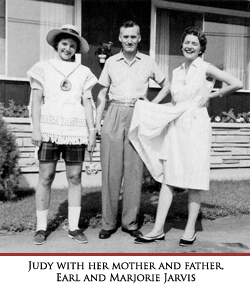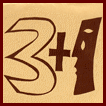 | ||||||||
When Judy was still an elementary student, the Jarvis family moved to Hillhurst Boulevard and she started school at nearby Havergal College, a conservative haven for girls of old Toronto families. Leal McBurney was Judy's friend and companion through her eleven years at Havergal. She recalls Judy as having been quite isolated from her classmates. For one thing, she was big -- by the time she was 8 or 9 she was 5 feet 2 inches tall. Leal recalls her as having been overwhelmingly singleminded. Judy's participation in school track events -- she was especially talented at the broadjump -- revealed her determination to win. In her teens Judy also got hooked on badminton winning several championships at the provincial and national levels. During this period of her life, she acquired a taste for the syndrome of sports performance, getting psyched up, expecting support for the consuming performance and plentiful admiration for the results. She acquired an urge to travel, and learned to savour throwing herself into unfamiliar competitive situations and winning. Everyone expected Judy to build a career on her stellar beginning in sport. She might have coached or competed at the Olympic level. Athletics were where she shone. Dancing was not on the professional horizon.
Upon her graduation from Havergal, Judy spent one year at Queen's University. She won the Alphie Pierce Trophy there for the most outstanding female athlete of the year. Then she returned to Toronto to complete her BA at the University of Toronto where she could maintain her interest in studying dance. Dance in Toronto at that time meant the fledgling National Ballet, Boris Volkoff's Russian methods and the performances of dancers on CBC music and variety programmes. Modern dance was very scarce in Toronto in the early 1960s. Among its proponents were Yone Kvietys, Nancy Lima Dent and Bianca Rogge. Judy made a connection at Bianca Rogge's downtown Toronto studio and soon became involved in performances at Rogge's Studio Dance Theatre. The studio put on a "showcase for modern dancers" every third Sunday evening of the month. The works were accompanied by the recorded music of Milhaud, Stockhausen, Messiaen, Sibelius, Gabrieli and Sammartini. Admission was seventy-five cents. Bianca Rogge was a graduate of the Mary Wigman School in Berlin, Germany. She had studied ballet as well as ''Theatre dance". Students in her school studied technique, composition and improvisation with a view to strengthening and freeing the body as an expressive instrument. The focus on making dances at the Rogge studio encouraged Judy to form a summer choreographic group of her own and she gave concerts in her parents' garden. Making up dances and performing them was an integral part of dance for Judy right from the beginning.
As a student at the University of Toronto she was looking through dance books at the library and made a discovery that would change her life. "I found this picture of Mary Wigman. She wasn't acting but moving in a way I imagined all my life. Something snapped. Right then I decided to go to Berlin and study with her ... the idea was pure instinct. But first, I had to get my degree. I was caught in a bind. To earn enough money to go to Berlin I needed a college degree. But to get one required much time and loneliness. My university life had nothing to do with dance ..." While never a distinguished student at the University of Toronto, Judy studied literature, history and modern languages, and obtained passable results, with marks in the sixties and seventies. She graduated in 1964 with a three-year Bachelor of Arts degree with a major in English and French literature. The next year she taught at St. Joseph's High School and, at the special request of the Toronto Order of St. Joseph, staged Henri Gheon's devotional play The Way of the Cross. Judy's version set the choric drama, inspired by ancient Greek theatre, into motion with twelve dancers, four actors and several musicians. But Judy was restless. She was dancing, she was performing, she was creating and staging work, but she wanted more. She had been a dutiful daughter up to now, indulging in an unusual but seemingly harmless desire to dance and perform. She was twenty-three. She had never left home for any length of time, and had made all the expected "right" moves for a girl of her generation and social standing.
Her aunt, Evelyn Brown, recalls that it was Bianca Rogge who urged Judy to study at the Wigman School. By encouragement, luck or instinct, she found the one person, Mary Wigman, whose philosophical commitment to the development of the individual voice in art, could suit her idiosyncratic physicality and fire her maverick spirit. Fighting her parents' reluctance to let her go, she prepared to leave for Berlin, embarking on a journey that would profoundly change the course of her life. (Next Page) ©2005, Dance Collection Danse | ||||
"Even the very first studies she did were amazingly inventive. There were the rest of us, and there was Judy." Marliese Kimmerle | ||||
"I found this picture of Mary Wigman. She wasn't acting but moving in a way I imagined all my life. Something snapped. Right then I decided to go to Berlin and study with her ..." Judy Jarvis | ||||
 The only daughter of a well-to-do family, Judith Anne Jarvis came into the world on June 5, 1942. Judy and her two brothers spent their early years in Ottawa and then on September 1, 1949, the Jarvis family moved to Toronto. Her mother's sister, Evelyn Brown, recalls this as the point when Judy's health began to change. Soon after the move she started to have trouble with her breathing and she was diagnosed as having asthma. The family then moved to Toronto's posh Bridle Path, further north in the city, presumably a healthier environment for Judy. The prescribed treatment for Judy's delicacy was activity. She would use medication for her respiratory problems throughout her life, and had asthmatic attacks into her adulthood. Paradoxically, breath was a signal feature of her dance. It was, in the end, the key of her life, an emblem of the essential quality of her art. Few of her dance friends knew anything about her breathing problems, and she never appeared to cater to her health.
The only daughter of a well-to-do family, Judith Anne Jarvis came into the world on June 5, 1942. Judy and her two brothers spent their early years in Ottawa and then on September 1, 1949, the Jarvis family moved to Toronto. Her mother's sister, Evelyn Brown, recalls this as the point when Judy's health began to change. Soon after the move she started to have trouble with her breathing and she was diagnosed as having asthma. The family then moved to Toronto's posh Bridle Path, further north in the city, presumably a healthier environment for Judy. The prescribed treatment for Judy's delicacy was activity. She would use medication for her respiratory problems throughout her life, and had asthmatic attacks into her adulthood. Paradoxically, breath was a signal feature of her dance. It was, in the end, the key of her life, an emblem of the essential quality of her art. Few of her dance friends knew anything about her breathing problems, and she never appeared to cater to her health.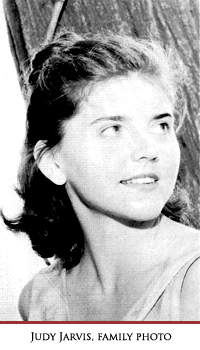 Evelyn Brown remembers the young Judy as curious and creative, always running, dancing or painting. From the time she was three years old, Evelyn recalls, Judy loved to dress up and perform. Certainly Judy was physically active, encouraged by medical opinion to pursue her love of figure skating. She had started figure skating at Ottawa's Minto Club then continued at the Granite Club in Toronto.
Evelyn Brown remembers the young Judy as curious and creative, always running, dancing or painting. From the time she was three years old, Evelyn recalls, Judy loved to dress up and perform. Certainly Judy was physically active, encouraged by medical opinion to pursue her love of figure skating. She had started figure skating at Ottawa's Minto Club then continued at the Granite Club in Toronto.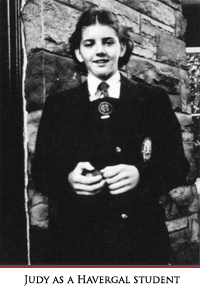 The earliest indication of dance training in her archives is a flyer from a 1957 summer school in Kingston. Judy studied ballet -- the Royal Academy of Dancing syllabus -- with Marjorie Haskins, as well as music and mime. In Toronto she studied with teacher Bettina Byers and with Gweneth Lloyd who taught ballet after school hours at Havergal.
The earliest indication of dance training in her archives is a flyer from a 1957 summer school in Kingston. Judy studied ballet -- the Royal Academy of Dancing syllabus -- with Marjorie Haskins, as well as music and mime. In Toronto she studied with teacher Bettina Byers and with Gweneth Lloyd who taught ballet after school hours at Havergal.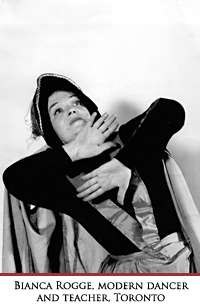 Fellow dancer Marliese Kimmerle said, "Even the very first studies she did were amazingly inventive. There were the rest of us, and there was Judy."
Fellow dancer Marliese Kimmerle said, "Even the very first studies she did were amazingly inventive. There were the rest of us, and there was Judy."